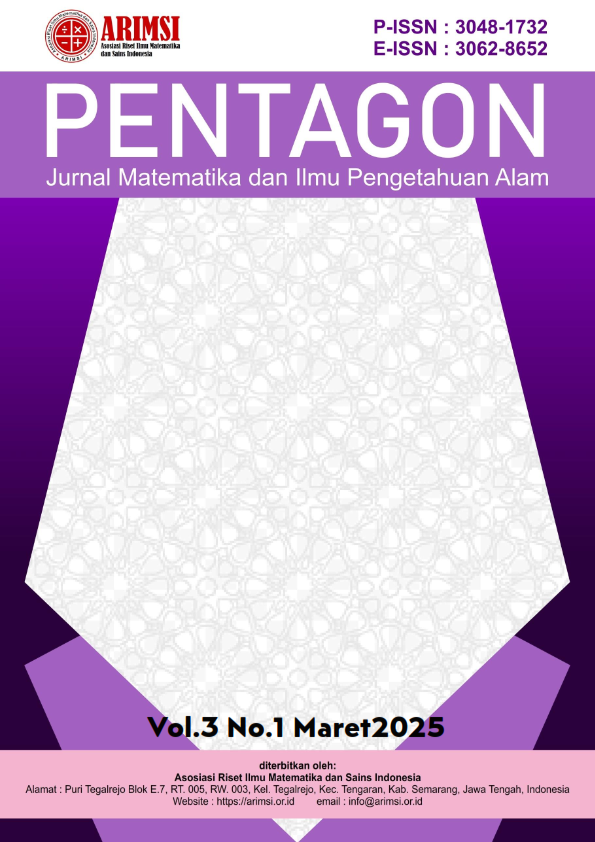Analisis Kemampuan Koneksi Matematis Peserta Ddidik Kelas I pada Pembelajaran Bangun Datar di Sekolah Dasar
DOI:
https://doi.org/10.62383/pentagon.v3i2.497Keywords:
first grade, flat shapes, geometry learning, mathematical connectionAbstract
Mathematical connection ability is a crucial competence that should be developed from the elementary level, as it helps students understand the interrelationships between mathematical concepts and their applications in daily life. This study aims to analyze the mathematical connection abilities of first-grade elementary school students in learning flat shapes. The research employed a descriptive quantitative method using cognitive and psychomotor assessment instruments. The cognitive test consisted of multiple-choice and essay questions measuring students' ability to recognize, understand, classify, and apply flat shapes. The psychomotor test involved tasks such as assembling flat shapes into meaningful objects and classifying shapes by type. The results showed that students were fairly capable of identifying and grouping flat shapes, but had difficulty explaining classification reasons or relating shapes to real-life objects. The psychomotor results also indicated that fine motor skills and the ability to make real-world connections need improvement. These findings highlight the importance of contextual learning approaches and the use of concrete media to strengthen students’ mathematical connections from an early age.
Downloads
References
Amanda, A., Hasanah, R. U., & Nurmala, S. (2024). Systematic literature review: kesulitan belajar mahasiswa pendidikan matematika. Bilangan: Jurnal Ilmiah Matematika, Kebumian dan Angkasa, 2(3), 73-86.
Amelinda, D., & Asbari, M. (2023). Transformasi Pendidikan PAUD dan Kesetaraan: Akselerasi Peningkatan dan Pendanaan. Journal of Information Systems and Management (JISMA), 2(6), 13-17.
Ariawan, R., & Putri, K. J. (2020). Pengembangan perangkat pembelajaran matematika dengan model pembelajaran problem based learning disertai pendekatan visual thinking pada pokok bahasan kubus dan balok kelas VIII. Juring (Journal for Research in Mathematics Learning), 3(3), 293-302.
Astuti, P. H. M., Margunayasa, I. G., & Suarjana, I. M. (2019). Pengembangan perangkat pembelajaran kolaboratif pada mata pelajaran matematika topik kubus dan balok. Jurnal Ilmiah Sekolah Dasar, 3(3), 269-277.
Balaka, M. Y. (2022). Metodologi penelitian kuantitatif.
Khabib, A. F., & Kurniawati, W. (2024). RM-Sains Klobot Card: Media pembelajaran unik dari limbah jagung yang teruji kelayakannya. Wiyata Dharma: Jurnal Penelitian dan Evaluasi Pendidikan, 12(2), 106-118.
Khawarizmi, A., Pendidikan, J., Matematika, P., Diklat, K. B., & Aceh, K. (2017). PENDIDIKAN MATEMATIKA DI SEKOLAH KITA. 1(1).
Kurniawan, R. 2006. Pembelajaran Dengan Pendekatan Kontekstual Untuk Meningkatkan Kemampuan Koneksi Matematik Siswa SMK. Tesis Tidak diterbitkan. Bandung: PPs UPI.
Lestari. K. E. dan Yudhanegara. M. R. (2017). Penelitian Pendidikan Matematika. Bandung: Refika Aditama.
Permana, Y., & Sumarmo, U. (2007). Mengembangkan kemampuan penalaran dan koneksi matematik siswa SMA melalui pembelajaran berbasis masalah. Jurnal Educationist, 1(2), 116-123.
Rohendi, D. & Dulpaja, J. 2013. Connected Mathematics Project (CMP) Model based on Presentation Media to the Mathematical Connection Ability of Junior High School Student. Journal of Education and Practice. 4(4):17-22.
Sugiyono. 2018. Metode Penelitian Kuantitatif. Bandung: Alfabeta.
Susanti, E., Rodiawati, A., & Syam, S. S. (2017). Discovery Learning Untuk Meningkatkan Kemampuan Pemahaman dan Koneksi Matematis. In Prosiding Seminar Nasional Matematika dan Pembelajarannya (p. 1113).
Unaenah, E., Hidyah, A., Aditya, A. M., Yolawati, N. N., Maghfiroh, N., Dewanti, R. R., & Safitri, T. (2020). Teori Brunner pada konsep bangun datar sekolah dasar. Nusantara, 2(2), 327-349.
Downloads
Published
How to Cite
Issue
Section
License
Copyright (c) 2025 Pentagon : Jurnal Matematika dan Ilmu Pengetahuan Alam

This work is licensed under a Creative Commons Attribution-ShareAlike 4.0 International License.





